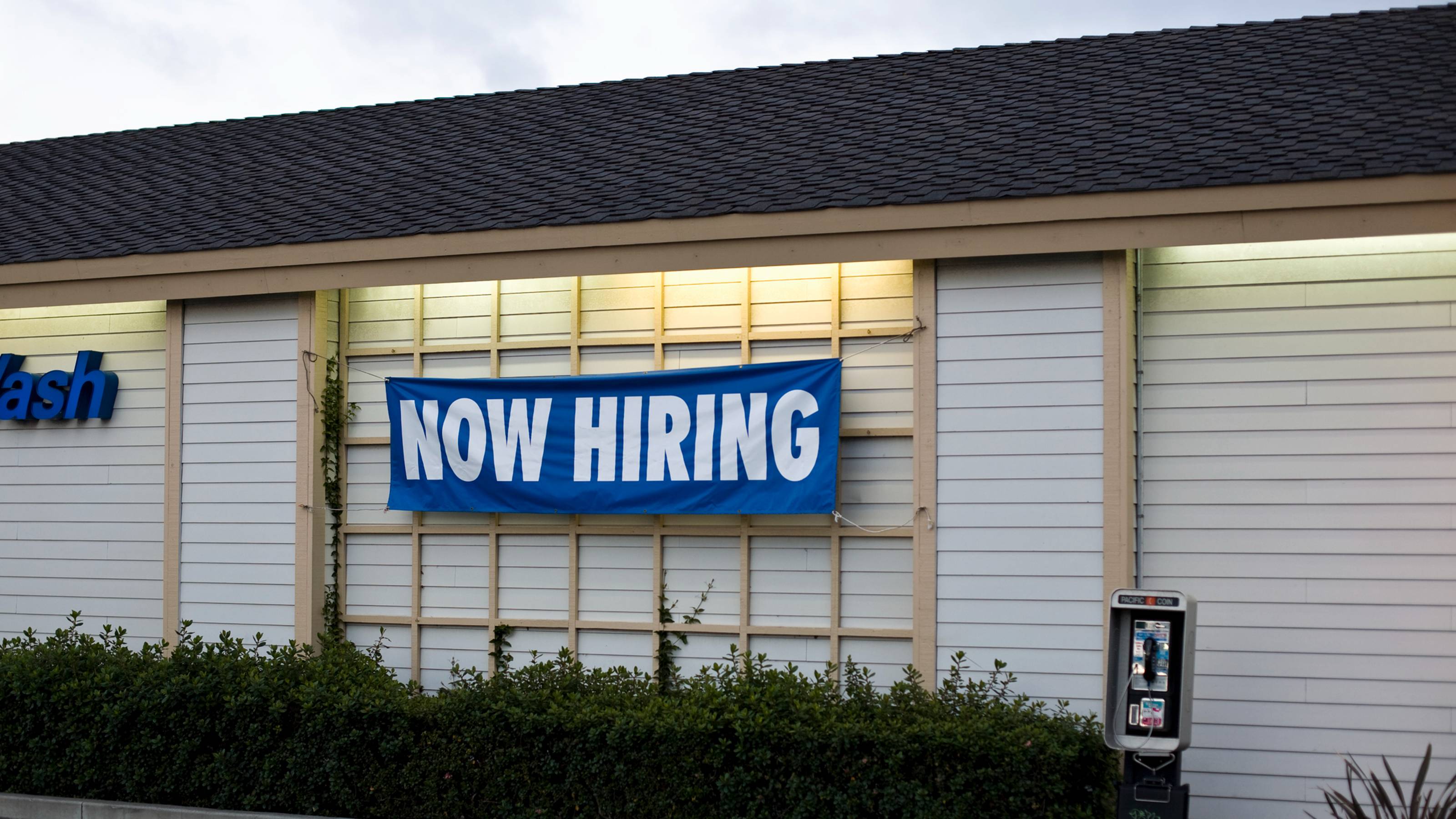October Jobs Report: What the Experts Are Saying
Market pros say a better-than-expected October jobs report complicates the Fed's fight against inflation.


The October jobs report easily topped economists' expectations despite nearly unprecedented efforts by the Federal Reserve to introduce slack into a squeaky tight labor market.
The Labor Department's employment situation summary released Friday revealed that nonfarm payrolls expanded by 261,000 in October, well ahead of estimates for new job growth of 193,000. Furthermore, employment gains in August and September combined were revised upward by 29,000.
Muddling the picture somewhat, the unemployment rate, which is derived from a separate survey, ticked up to 3.7% from 3.5% a month ago.
From just $107.88 $24.99 for Kiplinger Personal Finance
Become a smarter, better informed investor. Subscribe from just $107.88 $24.99, plus get up to 4 Special Issues

Sign up for Kiplinger’s Free Newsletters
Profit and prosper with the best of expert advice on investing, taxes, retirement, personal finance and more - straight to your e-mail.
Profit and prosper with the best of expert advice - straight to your e-mail.
The October jobs report comes two days after the Fed instituted a jumbo 0.75% increase in short-term interest rates for a fourth consecutive time. The central bank is determined to whip inflation, which is running at levels not seen in four decades.
Market reaction to the jobs report was initially mixed, with the blue-chip Dow Jones Industrial Average and broader S&P 500 moving higher early in the session. The tech-heavy Nasdaq Composite, which is more sensitive to rising interest rates, briefly sold off in early Friday trading before also turning positive. Ultimately, all three indexes, after flirting with losses at points during the day, finished the seesaw session with gains.
With the October jobs report now on the record, we decided to check in with economists, strategists, investment officers and other market pros to see what they have to say about the state of the economy, markets and the Fed's path going forward, among other matters. Please see a selection of expert commentary, sometimes edited for brevity, below:
- "The Labor Department announced that 261,000 payroll jobs were created in October, which was significantly higher than economists’ consensus estimate. August and September payrolls were also revised 29,000 higher. The unemployment rate rose to 3.7% in October, up from 3.5% in September, due to a shrinking workforce. Interestingly, the labor force participation rate declined to 62.2% in October, down from 62.3% in September. Average hourly earnings rose by 9 cents or 0.4% to $27.86 per hour in October and 4.7% in the past 12 months. Overall, since the payroll report was stronger than anticipated, the Fed will be under no pressure to stop increasing key interest rates." – Louis Navellier, chairman and founder of Navellier & Associates
- "The combination of a growing population with a smaller labor force will be a challenge in the Fed’s fight against inflation. The October employment-to-population ratio fell from September, illustrating the tight labor force. This measure is over a percentage point below the value in February 2020, prior to the pandemic. The number of those unemployed for over 27 weeks rose in October, increasing the risk of skill erosion for those out of work for an extended period. Over the past 12 months, average hourly earnings have increased by 4.7%, not keeping up with inflation. Notable job gains occurred in health care, professional and technical services, and manufacturing. Bottom Line: The sizable number of individuals who have not yet re-entered the workforce is complicating the Fed’s desire for a more balanced labor market. We expect the Fed to continue tightening policy as fighting inflation remains top priority." – Jeffrey Roach, chief economist at LPL Financial
- "The U.S. economy is operating at a very good level today and over the prior few months, which has been tremendously positive. We worry that the Fed is now accepting an ability to overtighten, potentially breaking a number of structures in today’s economy, particularly around real estate, which are hard to reconstruct with the Fed tools the Chairman described this week. As a result, we worry that this is akin to using a flamethrower at this point to solve a termite problem in what today is a very nice house for many in the country, during a largely supply-shock driven inflation environment. Avoiding overtightening would be more akin to just using termite repellant." – Rick Rieder, BlackRock’s chief investment officer of Global Fixed Income and head of the BlackRock Global Allocation Investment Team
- "The economy is slowing, but not enough to prompt a policy pivot from the Federal Reserve. It is too early to expect a Fed pivot, a view that appears to be shared by the bond market, but not the stock market, which rallied over the past month on hopes that the Fed may slow the pace of rate hikes. We continue to think that it is too early to expect the Fed to signal a more dovish stance, and expect markets to be choppy into year-end. Lower and more volatile growth, together with sticky inflation and elevated rates, should further challenge stocks and longer duration bonds." – Greg Marcus, managing director, UBS Private Wealth Management
- "The labor market is still tight but is cooling, with slowing payroll gains and a rise in unemployment. The Fed’s aggressive tightening measures, the end of stimulus programs, and high inflation are weighing on the economy. There is a notable disconnect between solid payroll growth and weaker growth of employment in the household survey. The Fed will likely make a smaller half-percentage point rate hike at its final scheduled decision of the year on December 14. The Fed will keep raising interest rates and slowing the economy until skeptics of their ability and determination to whip inflation are converted." – Bill Adams, chief economist for Comerica Bank
- "U.S. job reports for October provided a mixed read on the health of the labor market, with payrolls growth once again coming in stronger than expected, but household-survey jobs contracting and sending the unemployment rate higher. While the pace of hiring is slowing – down from this year's average of 407,000 and last year's mean of 562,000 – it's still too hot for an inflation-fighting Fed. The more volatile household survey, however, cast a darker light on the jobs market. Bottom Line: A mixed U.S. jobs report might give the Fed some leeway to at least downsize the next rate hike in December. However, payrolls are still expanding far too fast, suggesting the unemployment rate could stay low for longer. That means the terminal policy rate could well be pushed higher than the FOMC previously thought, as Powell warned this week." – Sal Guatieri, senior economist at BMO Capital Markets
- "This was a very strong employment report, with the education and health services sector leading the way. Nonfarm payrolls remained stubbornly high in October even though household employment was down during the same month. The fall in household employment pushed the rate of unemployment higher in October compared to September. While August’s increase in the rate of unemployment was due to an increase in the labor force participation rate, October’s increase in the rate of unemployment was due to lower employment numbers coming from the household survey." – Eugenio Alemán, chief economist at Raymond James
- "Job growth was generally broad-based, led by healthcare, professional & business services and manufacturing. Yet, beneath the surface there were some signs in the data that cracks are emerging in the labor market. Technical factors related to the birth-death model appear to be flattering the headline nonfarm payroll numbers. Employment as measured by the household survey fell by 328,000 in October, and the labor force participation rate once again tumbled back to where it was when the year began. Our sense is that the Federal Open Market Committee would prefer to hike by 'only' 0.5% in December, but hot economic data could force the Committee's hand to once again go 0.75%. On net, we doubt today's data move the needle much toward a 0.75% hike. A 0.5% rate hike remains our base case, with next Thursday's Consumer Price Index print the next pivotal piece of data." – Sarah House, senior economist at Wells Fargo Economics
- "A decent jobs number of 261,000 beat the expected 193,000 jobs which, on the surface, is bad for markets as Fed Chair Powell wants to destroy roughly a million jobs (mistakenly thinking reduced demand for jobs is the secret to reducing inflation) and this number might mean they stay aggressive with rate hikes. However, the Fed has succeeded in hurting wage growth with three-month wage growth having declined to an annualized rate of just 3.9%. Tough news for workers considering how much wage growth is lagging inflation. Powell should also be pleased that the unemployment rate went up from 3.6% to 3.7%. All members of the Fed want and are expecting unemployment to rise at least a full percentage point." – Bryce Doty, senior portfolio manager at Sit Fixed Income Advisors
- "The big picture here is of a normalizing labor market, one where hiring is slowly trending down, but remains at very healthy levels. Given the job openings levels, it is likely that part of the slowdown in hiring is due to a shortage of labor – there simply are not enough candidates – rather than a lack of demand. So, what does this mean for the economy – and markets? The Fed will welcome the slowdown in job and wage growth, but they still likely remain too high to contain inflation, so expect continued tight policy in the short run. As long as job growth stays healthy, so will demand growth, and so will inflation. But the slowing trend is good news and suggests we might be back to something like normal in the next six months or so – which could lead to a Fed pause." – Brad McMillan, chief investment officer at Commonwealth Financial Network
Profit and prosper with the best of Kiplinger's advice on investing, taxes, retirement, personal finance and much more. Delivered daily. Enter your email in the box and click Sign Me Up.

Dan Burrows is Kiplinger's senior investing writer, having joined the publication full time in 2016.
A long-time financial journalist, Dan is a veteran of MarketWatch, CBS MoneyWatch, SmartMoney, InvestorPlace, DailyFinance and other tier 1 national publications. He has written for The Wall Street Journal, Bloomberg and Consumer Reports and his stories have appeared in the New York Daily News, the San Jose Mercury News and Investor's Business Daily, among many other outlets. As a senior writer at AOL's DailyFinance, Dan reported market news from the floor of the New York Stock Exchange.
Once upon a time – before his days as a financial reporter and assistant financial editor at legendary fashion trade paper Women's Wear Daily – Dan worked for Spy magazine, scribbled away at Time Inc. and contributed to Maxim magazine back when lad mags were a thing. He's also written for Esquire magazine's Dubious Achievements Awards.
In his current role at Kiplinger, Dan writes about markets and macroeconomics.
Dan holds a bachelor's degree from Oberlin College and a master's degree from Columbia University.
Disclosure: Dan does not trade individual stocks or securities. He is eternally long the U.S equity market, primarily through tax-advantaged accounts.
-
 Top Tech Gifts to Grab at Walmart Before Christmas
Top Tech Gifts to Grab at Walmart Before ChristmasBig savings on Apple, Bose, HP, Vizio and more while there's still time to shop.
-
 AI Appliances Aren’t Exciting Buyers…Yet
AI Appliances Aren’t Exciting Buyers…YetThe Kiplinger Letter Artificial intelligence is being embedded into all sorts of appliances. Now sellers need to get customers to care about AI-powered laundry.
-
 Ask the Editor: IRAs, 401(k)s and RMDs
Ask the Editor: IRAs, 401(k)s and RMDsAsk the Editor In this week's Ask the Editor Q&A, Joy Taylor answers questions on IRAs, 401(k)s and required minimum distributions
-
 Dow Adds 646 Points, Hits New Highs: Stock Market Today
Dow Adds 646 Points, Hits New Highs: Stock Market TodayIt was "boom" for the Dow but "bust" for the Nasdaq following a December Fed meeting that was less hawkish than expected.
-
 Dow Rises 497 Points on December Rate Cut: Stock Market Today
Dow Rises 497 Points on December Rate Cut: Stock Market TodayThe basic questions for market participants and policymakers remain the same after a widely expected Fed rate cut.
-
 JPMorgan's Drop Drags on the Dow: Stock Market Today
JPMorgan's Drop Drags on the Dow: Stock Market TodaySmall-cap stocks outperformed Tuesday on expectations that the Fed will cut interest rates on Wednesday.
-
 Stocks Slip to Start Fed Week: Stock Market Today
Stocks Slip to Start Fed Week: Stock Market TodayWhile a rate cut is widely expected this week, uncertainty is building around the Fed's future plans for monetary policy.
-
 December Fed Meeting: Updates and Commentary
December Fed Meeting: Updates and CommentaryThe December Fed meeting is one of the last key economic events of 2025, with Wall Street closely watching what Chair Powell & Co. will do about interest rates.
-
 Stocks Keep Climbing as Fed Meeting Nears: Stock Market Today
Stocks Keep Climbing as Fed Meeting Nears: Stock Market TodayA stale inflation report and improving consumer sentiment did little to shift expectations for a rate cut next week.
-
 Small Caps Hit a New High on Rate-Cut Hope: Stock Market Today
Small Caps Hit a New High on Rate-Cut Hope: Stock Market TodayOdds for a December rate cut remain high after the latest batch of jobs data, which helped the Russell 2000 outperform today.
-
 UNH Sparks a 408-Point Surge for the Dow: Stock Market Today
UNH Sparks a 408-Point Surge for the Dow: Stock Market TodayThe best available data right now confirm both a slowing employment market and a December rate cut, a tension reflected at the equity index level.